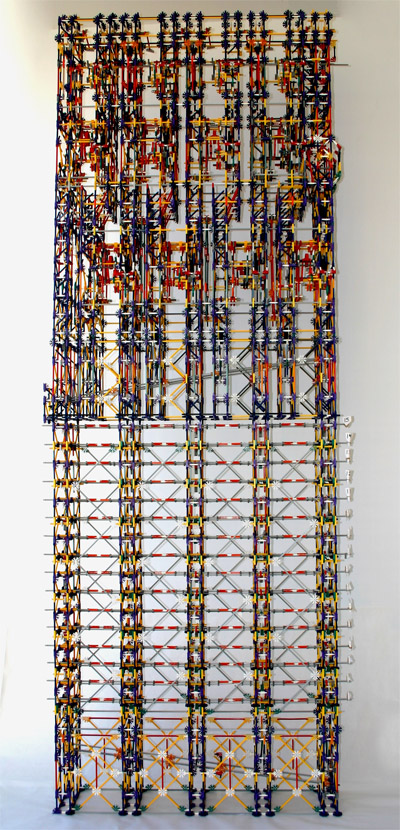KNEX Calculator
 The K'NEX calculator stands over 10 feet tall, and can perform 4 bit addition and subtraction operations in about 30 seconds. The slowest part of the operation is the user entering the balls. From there the balls trickle down, computing the result of the operation, and then sending that through a 4 bit decoder, which flips a flag that tells the user the answer. Since it is 4 bit, we can add and subtract numbers from 0 to 15.
The calculator uses 9 balls to perform a computation: 4 for the first number, 1 for the operation (add or subtract) and 4 for the second number. The first ball to go in also resets all the display flags.
As the balls enter, they go into different logic gates, setting states and waiting. For more information on how the gates work, check out the Ball Theory section.
The denser looking, top half of the machine is the adder / subtracter. It outputs a 4-bit binary answer. Under that is the 4-bit binary decoder which displays the answer in decimal on a flag.
The K'NEX calculator stands over 10 feet tall, and can perform 4 bit addition and subtraction operations in about 30 seconds. The slowest part of the operation is the user entering the balls. From there the balls trickle down, computing the result of the operation, and then sending that through a 4 bit decoder, which flips a flag that tells the user the answer. Since it is 4 bit, we can add and subtract numbers from 0 to 15.
The calculator uses 9 balls to perform a computation: 4 for the first number, 1 for the operation (add or subtract) and 4 for the second number. The first ball to go in also resets all the display flags.
As the balls enter, they go into different logic gates, setting states and waiting. For more information on how the gates work, check out the Ball Theory section.
The denser looking, top half of the machine is the adder / subtracter. It outputs a 4-bit binary answer. Under that is the 4-bit binary decoder which displays the answer in decimal on a flag.
Posted by
Matt Donahoe
21
comments
![]()